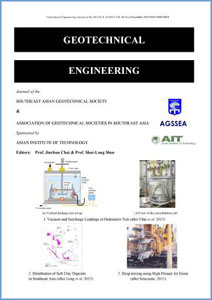Design and Performance of Soft Ground Improvement Using PVD with and without Vacuum Consolidation
Main Article Content
Abstract
This paper presents the soft ground improvement using Prefabricated Vertical Drains (PVD) including PVD installation and preloading techniques, settlement and stability design calculations, observational methods and back analyses of monitoring data and performance of conventional preloading with surcharge fill and preloading using vacuum consolidation method (VCM) in combination with fill embankment. Several case histories were studied. The monitored data illustrated that the effectiveness of VCM is dependent on the method of applying vacuum pressure to the PVDs. Measured pore pressure in the PVDs at different depths indicated that the effective vacuum pressure inside the PVDs is distributed uniformly along the PVD depth with a magnitude of over 80 kPa for VCM using airtight membrane. Back-calculated ch values from measured settlement data using Asaoka method confirmed that with the assumed values of ds/dm = 2 and kh/ks = 2, the corresponding value of ch/cv,oed = 3 to 5 were obtained for both soft Bangkok (BKK) clay and soft clays in Mekong River Delta (MRD). Also, the linear relationship between compression index and water content for soft clays in MRD is similar to that of BKK clay. The settlements versus time calculated by 1-D method are in very good comparison with measured data for both conventional preloading and VCM considering the vacuum pressure as an induced vertical stress distributed uniformly in the PVD zone. From the results presented in this paper, simple procedures can be made for selection of soil parameters and design calculations of embankments on PVD improved soft ground using conventional preloading and vacuum consolidation.
Article Details

This work is licensed under a Creative Commons Attribution-NonCommercial-NoDerivatives 4.0 International License.
Copyright © 2019 Association of Geotechnical Societies in Southeast Asia (AGSSEA) - Southeast Asian Geotechnical Society (SEAGS).


